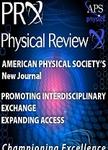版权所有:内蒙古大学图书馆 技术提供:维普资讯• 智图
内蒙古自治区呼和浩特市赛罕区大学西街235号 邮编: 010021

作者机构:Department of Physics and Institute of Theoretical Physics Nanjing Normal University Nanjing Jiangsu 210023 People’s Republic of China Institute of Theoretical Physics Shanxi University Taiyuan Shanxi 030006 China Jiangsu Key Laboratory for Numerical Simulation of Large Scale Complex Systems Nanjing Normal University Nanjing Jiangsu 210023 People’s Republic of China
出 版 物:《Physical Review D》 (物理学评论D辑:粒子、场、重力与宇宙学)
年 卷 期:2017年第96卷第3期
页 面:036014-036014页
核心收录:
学科分类:07[理学] 070201[理学-理论物理] 0702[理学-物理学]
基 金:National Natural Science Foundation of China, NSFC, (11235005, 11547038) National Natural Science Foundation of China, NSFC
主 题:Branching fraction Hadronic decays
摘 要:In this work, we calculate the CP-averaged branching ratios and direct CP-violating asymmetries of the quasi-two-body decays B(s)→Pρ′(1450),Pρ′′(1700)→Pππ by employing the perturbative QCD (PQCD) factorization approach, where P is a light pseudoscalar meson K, π, η, and η′. The considered decay modes are studied in the quasi-two-body framework by parametrizing the two-pion distribution amplitude ΦππP. The P-wave timelike form factor Fπ in the resonant regions associated with the ρ′(1450) and ρ′′(1700) is estimated based on available experimental data. The PQCD predictions for the CP-averaged branching ratios of the decays B(s)→Pρ′(1450),Pρ′′(1700)→Pππ are in the order of 10−7−10−9. The branching ratios of the two-body decays B(s)→Pρ′(1450),Pρ′′(1700) are extracted from the corresponding quasi-two-body decay modes. The whole pattern of the squared pion form factor |Fπ|2 measured by BABAR Collaboration could also be understood based on our studies. The PQCD predictions in this work will be tested by the precise data from the LHCb and the future Belle II experiments.